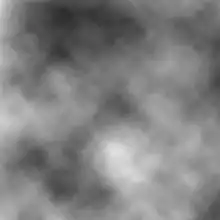Value noise
Value noise is a type of noise commonly used as a procedural texture primitive in computer graphics. It is conceptually different from, and often confused with gradient noise, examples of which are Perlin noise and Simplex noise. This method consists of the creation of a lattice of points which are assigned random values. The noise function then returns the interpolated number based on the values of the surrounding lattice points.

2D Value noise rescaled and added onto itself to create fractal noise
For many applications, multiple octaves of this noise can be generated and then summed together, just as can be done with Perlin noise and Simplex noise, in order to create a form of fractal noise.
External links
- Elias, Hugo. "Perlin noise". freespace.virgin.net. Archived from the original on 2008-07-24. - an explanation and implementation of Value Noise, mislabeled as Perlin noise.
- Lesson explaining in a very simple way how Value Noise works (with examples in C++)
References
This article is issued from Wikipedia. The text is licensed under Creative Commons - Attribution - Sharealike. Additional terms may apply for the media files.